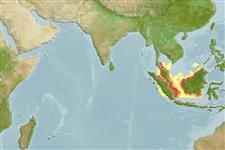>
Clupeiformes (Herrings) >
Engraulidae (Anchovies) > Coiliinae
Etymology: Setipinna: Latin, septem = seven + Latin, pinna, -ae = fin.
Environment: milieu / climate zone / intervalo de profundidade / distribution range
Ecologia
marinhas; estuarina pelagic-neritic. Tropical; 9°N - 5°S, 99°E - 117°E (Ref. 189)
Western Central Pacific: river mouths of Sumatra, Kalimantan and Sarawak, presumably also Java. Reported from India, Bangladesh and Myanmar (Ref. 45255).
Tamanho / Peso / Idade
Maturidade: Lm ? range ? - ? cm
Max length : 24.0 cm SL macho/indeterminado; (Ref. 189)
Espinhos dorsais (total) : 0; Espinhos anais: 0; Raios anais moles: 59 - 64. Body compressed, head very short, belly with 17 to 23 plus 9 to 11 = 27 to 32 scutes from isthmus to anus. Mouth strongly oblique, lower jaw projecting beyond the tip of the snout. Its very low gill raker count and the characteristic shape of its head and jaws distinguishes it from all other species of Setipinna.
Body shape (shape guide): elongated; Cross section: compressed.
A marine or estuarine species, but perhaps also ascending into freshwater. More data needed. Apparently a highly esteemed foodfish at the Rokan River mouth, Sumatra and presumably so in similar localities elsewhere in Indonesia, Malaysia and Sarawak.
Life cycle and mating behavior
Maturidade | Reprodução | Desova | Ovos | Fecundidade | Larvas
Wongratana, T., T.A. Munroe and M. Nizinski, 1999. Order Clupeiformes. Engraulidae. Anchovies. p. 1698-1753. In K.E. Carpenter and V.H. Niem (eds.) FAO species identification guide for fishery purposes. The living marine resources of the WCP. Vol. 3. Batoid fishes, chimaeras and bony fishes part 1 (Elopidae to Linophrynidae). FAO, Rome. (Ref. 9822)
Categoria na Lista Vermelha da IUCN (Ref. 130435: Version 2025-1)
Ameaça para o homem
Harmless
Utilização humana
Pescarias: espécies comerciais
Ferramentas
Relatórios especiais
Descarregue XML
Fontes da internet
Estimates based on models
Preferred temperature (Ref.
123201): 28.2 - 29.3, mean 28.9 °C (based on 280 cells).
Phylogenetic diversity index (Ref.
82804): PD
50 = 0.5039 [Uniqueness, from 0.5 = low to 2.0 = high].
Bayesian length-weight: a=0.00380 (0.00174 - 0.00830), b=3.11 (2.93 - 3.29), in cm total length, based on LWR estimates for this (Sub)family-body shape (Ref.
93245).
Nível Trófico (Ref.
69278): 3.6 ±0.5 se; based on size and trophs of closest relatives
Resiliência (Ref.
120179): Médio, tempo mínimo de duplicação da população 1,4 - 4,4 anos (K=0.23).
Fishing Vulnerability (Ref.
59153): Low vulnerability (19 of 100).
🛈
